Factors Controlling the Variation of Aerosol Surface Area Concentrations Measured by a Diffusion Charger in Fukuoka, Japan
Abstract
:1. Introduction
2. Experiments
2.1. Monitoring Period and Site
2.2. Aerosol Surface Area
2.3. Aerosol Chemical Composition, Number and Mass Concentration, and Sulfur Dioxide Concentration
2.4. Airmass Backward Trajectory Analysis
3. Results and Discussion
3.1. Aerosol Surface Area is Generally Controlled by Black Carbon
3.2. Case Study: Aerosol Surface Area is Occasionally Controlled by Sulfate
4. Conclusions
Acknowledgments
Author Contributions
Conflicts of Interest
Abbreviations
| BC: | Black Carbon |
| BET: | Brunauer-Emmett-Teller method |
| ICRP: | International Commission on Radiological Protection |
| LDSA: | Lung deposited surface area |
| NSAM: | Nanoparticle surface area monitor |
| Q-AMS: | Quadrupole type aerosol mass spectrometer |
References
- Dockery, D.W.; Pope, C.A., III; Xu, X.; Spengler, J.D.; Ware, J.H.; Fay, M.E.; Ferris, B.G., Jr.; Speizer, F.E. An association between air pollution and mortality in six U.S. cities. N. Engl. J. Med. 1993, 329, 1753–1759. [Google Scholar] [CrossRef] [PubMed]
- Pope, C.A., III; Thun, M.J.; Namboodiri, M.M.; Dockery, D.W.; Evans, J.S.; Speizer, F.E.; Heath, C.W., Jr. Particulate air pollution as a predictor of mortality in a prospective study of U.S. adults. Am. J. Respir. Crit. Care Med. 1995, 151, 669–674. [Google Scholar] [CrossRef] [PubMed]
- International Agency for Research on Cancer. Air Pollution and Cancer; IARC Scientific Publication: Lyon, France, 2013; No. 161. [Google Scholar]
- Donaldson, K.; Li, X.Y.; MacNee, W. Ultrafine (nanometre) particle mediated lung injury. J. Aerosol Sci. 1998, 29, 553–560. [Google Scholar] [CrossRef]
- Oberdörster, G.; Gelein, R.M.; Ferin, J.; Weiss, B. Association of particulate air pollution and acute mortality: Involvement of ultrafine particles? Inhal. Toxicol. 1995, 7, 111–124. [Google Scholar] [CrossRef] [PubMed]
- The National Institute for Occupational Safety and Health (NIOSH). The National Institute for Occupational Safety and Health (NIOSH): Approaches to Safe Nanotechnology; DHHS (NIOSH) Publication No. 2009-125; The National Institute for Occupational Safety and Health (NIOSH): Washington, DC, USA, 2009.
- Ferin, J.; Oberdörster, G.; Penney, D.P. Pulmonary retention of ultrafine and fine particles in rats. Am. J. Respir. Cell Mol. Biol. 1992, 6, 535–542. [Google Scholar] [CrossRef] [PubMed]
- Nakanishi, J. Risk Assessment of Manufactured Nanomaterials: Carbon Nanotubes (CNT). Final Report Issued on August 12, 2011, Executive Summary; NEDO project “Research and Development of Nanoparticle Characterization Methods.” (P06041); New Energy and Industrial Technology Development Organization: Kawasaki, Japan, 2011. [Google Scholar]
- Oberdörster, G.; Finkelstein, J.N.; Johnston, C.; Gelein, R.; Cox, C.; Baggs, R.; Elder, A.C.P. Acute pulmonary effects of ultrafine particles in rats and mice. Res. Rep. Health Eff. Inst. 2000, 96, 5–74. [Google Scholar] [PubMed]
- Oberdörster, G.; Oberdörster, E.; Oberdörster, J. Nanotoxicology: An emerging discipline evolving from studies of ultrafine particles. Environ. Health Perspect. 2005, 113, 823–839. [Google Scholar] [CrossRef] [PubMed]
- Giechaskiel, B.; Alföldy, B.; Drossinos, Y. A metric for health effects studies of diesel exhaust particles. J. Aerosol Sci. 2009, 40, 639–651. [Google Scholar] [CrossRef]
- Oberdörster, G. Pulmonary effects of inhaled ultrafine particles. Int. Arch. Occup. Environ. Health 2001, 74, 1–8. [Google Scholar] [CrossRef] [PubMed]
- Brunauer, S.; Emmett, P.H.; Teller, E. Adsorption of gases in multimolecular layers. J. Am. Chem. Soc. 1938, 60, 309–319. [Google Scholar] [CrossRef]
- Okuda, T. Measurement of the specific surface area and particle size distribution of atmospheric aerosol reference materials. Atmos. Environ. 2013, 75, 1–5. [Google Scholar] [CrossRef]
- Okuda, T.; Isobe, R.; Nagai, Y.; Okahisa, S.; Funato, K.; Inoue, K. Development of a high-volume PM2.5 particle sampler using impactor and cyclone techniques. Aerosol Air Qual. Res. 2015, 15, 759–767. [Google Scholar] [CrossRef]
- Hatoya, K.; Okuda, T.; Funato, K.; Inoue, K. On-line measurement of the surface area concentration of aerosols in Yokohama, Japan, using the diffusion charging method. Asian J. Atmos. Environ. 2016, in press. [Google Scholar]
- Fissan, H.; Neumann, S.; Trampe, A.; Pui, D.Y.H.; Shin, W.G. Rationale and principle of an instrument measuring lung deposited nanoparticle surface area. J. Nanopart. Res. 2007, 9, 53–59. [Google Scholar] [CrossRef]
- Heitbrink, W.A.; Evans, D.E.; Ku, B.K.; Maynard, A.D.; Slavin, T.J.; Peters, T.M. Relationships among particle number, surface area, and respirable mass concentrations in automotive engine manufacturing. J. Occup. Environ. Hyg. 2009, 6, 19–31. [Google Scholar] [CrossRef] [PubMed]
- Jung, H.; Kittelson, D.B. Characterization of aerosol surface instruments in transition regime. Aerosol Sci. Technol. 2005, 39, 902–911. [Google Scholar] [CrossRef]
- Shin, W.G.; Pui, D.Y.H.; Fissan, H.; Neumann, S.; Trampe, A. Calibration and numerical simulation of Nanoparticle Surface Area Monitor (TSI Model 3550 NSAM). J. Nanopart. Res. 2007, 9, 61–69. [Google Scholar] [CrossRef]
- Asbach, C.; Fissan, H.; Stahlmecke, B.; Kuhlbusch, T.A.J.; Pui, D.Y.H. Conceptual limitations and extensions of lung-deposited Nanoparticle Surface Area Monitor (NSAM). J. Nanopart. Res. 2009, 11, 101–109. [Google Scholar] [CrossRef]
- Gomes, J.F.P.; Albuquerque, P.C.S.; Esteves, H.M.D.S.; Carvalho, P.A. Notice on a methodology for characterizing emissions of ultrafine particles/nanoparticles in microenvironments. Energy Emiss. Cont. Technol. 2013, 1, 15–27. [Google Scholar] [CrossRef]
- Albuquerque, P.C.; Gomes, J.F.; Bordado, J.C. Assessment of exposure to airborne ultrafine particles in the urban environment of Lisbon, Portugal. J. Air Waste Manag. Assoc. 2012, 62, 373–380. [Google Scholar] [CrossRef] [PubMed]
- Ntziachristos, L.; Polidori, A.; Phuleria, H.; Geller, M.D.; Sioutas, C. Application of a diffusion charger for the measurement of particle surface concentration in different environments. Aerosol Sci. Technol. 2007, 41, 571–580. [Google Scholar] [CrossRef]
- Velasco, E.; Siegmann, P.; Siegmann, H.C. Exploratory study of particle-bound polycyclic aromatic hydrocarbons in different environments of Mexico City. Atmos. Environ. 2004, 38, 4957–4968. [Google Scholar] [CrossRef]
- China, S.; Salvadori, N.; Mazzoleni, C. Effect of traffic and driving characteristics on morphology of atmospheric soot particles at freeway on-ramps. Environ. Sci. Technol. 2014, 48, 3128–3135. [Google Scholar] [CrossRef] [PubMed]
- Kaneyasu, N.; Yamamoto, S.; Sato, K.; Takami, A.; Hayashi, M.; Hara, K.; Kawamoto, K.; Okuda, T.; Hatakeyama, S. Impact of long-range transport of aerosols on the PM2.5 composition at a major metropolitan area in the northern Kyushu area of Japan. Atmos. Environ. 2014, 97, 416–425. [Google Scholar] [CrossRef]
- Takami, A.; Miyoshi, T.; Irei, S.; Yoshino, A.; Sato, K.; Shimizu, A.; Hayashi, M.; Hara, K.; Kaneyasu, N.; Hatakeyama, S. Analysis of organic aerosol in Fukuoka, Japan using a PMF method. Aerosol Air Qual. Res. 2016, 16, 314–322. [Google Scholar] [CrossRef]
- Kaneyasu, N.; Takami, A.; Sato, K.; Hatakeyama, S.; Hara, S.; Kawamoto, K.; Yamamoto, S. Year-round behavior of PM2.5 in a remote island and urban site in the northern Kyushu area, Japan. J. Jpn. Soc. Atmos. Environ. 2011, 46, 111–118. (In Japanese) [Google Scholar]
- International Commission on Radiological Protection (ICRP). Human respiratory tract model for radiological protection. Ann. ICRP 1994, 24, 1–482. [Google Scholar]
- Ng, I.P.; Ma, H.; Kittelson, D.B.; Miller, A.L. Comparing Measurements of Carbon in Diesel Exhaust Aerosols Using the Aethalometer, NIOSH Method 5040, and SMPS; SAE Technical Paper Series 2007-01-0334; University of Minnesota: Minneapolis, MN, USA, 2007. [Google Scholar]
- Venkatachari, P.; Zhou, L.; Hopke, P.K.; Schwab, J.J.; Demerjian, K.L.; Weimer, S.; Hogrefe, O.; Felton, D.; Rattigan, O. An intercomparison of measurement methods for carbonaceous aerosol in the ambient air in New York City. Aerosol Sci. Technol. 2006, 40, 788–795. [Google Scholar] [CrossRef]
- Jayne, J.T.; Leard, D.C.; Zhang, X.; Davidovits, P.; Smith, K.A.; Kolb, C.E.; Worsnop, D.R. Development of an aerosol mass spectrometer for size and composition analysis of submicron particles. Aerosol Sci. Technol. 2000, 33, 49–70. [Google Scholar] [CrossRef]
- Allan, J.D.; Jimenez, J.L.; Coe, H.; Bower, K.N.; Williams, P.I.; Worsnop, D.R. Quantitative sampling using an Aerodyne aerosol mass spectrometer: Part 1. Techniques of data interpretation and error analysis. J. Geophys. Res. 2003, 108, 4090. [Google Scholar] [CrossRef]
- Allan, J.D.; Alfarra, M.R.; Bower, K.N.; Williams, P.I.; Gallagher, M.W.; Jimenez, J.L.; McDonald, A.G.; Nemitz, E.; Canagaratna, M.R.; Jayne, J.T.; et al. Quantitative sampling using an aerodyne aerosol mass spectrometer: Part 2. Measurements of fine particulate chemical composition in two U.K. cities. J. Geophys. Res. 2003b, 108. [Google Scholar] [CrossRef]
- Jimenez, J.L.; Jayne, J.T.; Shi, Q.; Kolb, C.E.; Worsnop, D.R.; Yourshaw, I.; Seinfeld, J.H.; Flagan, R.C.; Zhang, X.; Smith, K.A.; et al. Ambient aerosol sampling using the aerodyne aerosol mass spectrometer. J. Geophys. Res. 2003, 108. [Google Scholar] [CrossRef]
- Takami, A.; Miyoshi, T.; Shimono, A.; Hatakeyama, S. Chemical composition of fine aerosol measured by AMS at Fukue Island, Japan during APEX period. Atmos. Environ. 2005, 39, 4913–4924. [Google Scholar] [CrossRef]
- Canagaratna, M.R.; Jayne, J.T.; Jimenez, J.L.; Allan, J.D.; Alfarra, M.R.; Zhang, Q.; Onasch, T.B.; Drewnick, F.; Coe, H.; Middlebrook, A.; et al. Chemical and microphysical characterization of ambient aerosols with the aerodyne aerosol mass spectrometer. Mass Spectrom. Rev. 2007, 26, 185–222. [Google Scholar] [CrossRef] [PubMed]
- Takami, A.; Miyoshi, T.; Shimono, A.; Kaneyasu, N.; Kato, S.; Kajii, Y.; Hatakeyama, S. Transport of anthropogenic aerosols from Asia and subsequent chemical transformation. J. Geophys. Res. 2007, 112, D22S31. [Google Scholar] [CrossRef]
- Allan, J.D.; Coe, H.; Bower, K.N.; Alfarra, M.R.; Delia, A.E.; Jimenez, J.L.; Middlebrook, A.M.; Drewnick, F.; Onasch, T.B.; Canagaratna, M.R.; et al. A generalized method for the extraction of chemically resolved mass spectra from aerodyne aerosol mass spectrometer data. J. Aerosol. Sci. 2004, 35, 909–922. [Google Scholar] [CrossRef]
- Fukuoka Prefecture Website. Available online: http://www.fihes.pref.fukuoka.jp/taiki-new/Nipo/OyWbNpKm0151.htm (accessed on 14 January 2016).
- Kagoshima Prefecture Website. Available online: http://www.pref.kagoshima.jp/ (accessed on 14 January 2016).
- Draxler, R.R.; Rolph, G.D. HYSPLIT (HYbrid Single-Particle Lagrangian Integrated Trajectory) Model Access via NOAA ARL READY Website; NOAA Air Resources Laboratory: Silver Spring, MD, USA, 2015. [Google Scholar]
- Rolph, G.D. Real-time Environmental Applications and Display sYstem (READY) Website; NOAA Air Resources Laboratory: Silver Spring, MD, USA, 2015. [Google Scholar]
- Polidori, A.; Hu, S.; Biswas, S.; Delfino, R.J.; Sioutas, C. Real-time characterization of particle-bound polycyclic aromatic hydrocarbons in ambient aerosols and from motor-vehicle exhaust. Atmos. Chem. Phys. 2008, 8, 1277–1291. [Google Scholar] [CrossRef]
- Nagatani, T.; Yamada, M.; Kojima, T.; Zhang, D. Episodic particulate sulfate and sulfur dioxide on the southwestern Japan coast in March and April 2010. Asian J. Atmos. Environ. 2012, 6, 41–52. [Google Scholar] [CrossRef]
- Boulon, J.; Sellegri, K.; Hervo, M.; Laj, P. Observations of nucleation of new particles in a volcanic plume. Proc. Natl. Acad. Sci. 2011, 30, 12223–12226. [Google Scholar] [CrossRef] [PubMed]
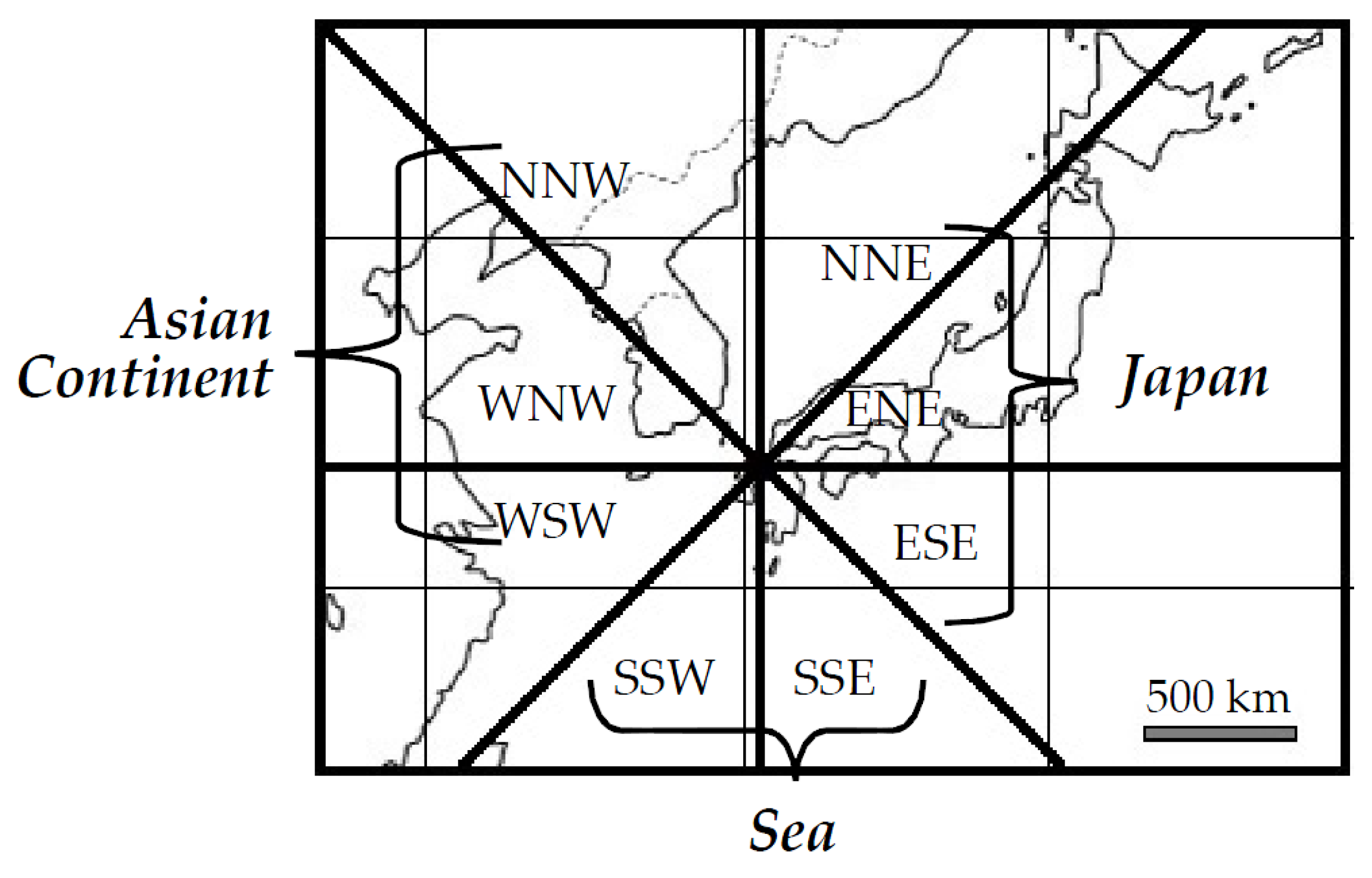

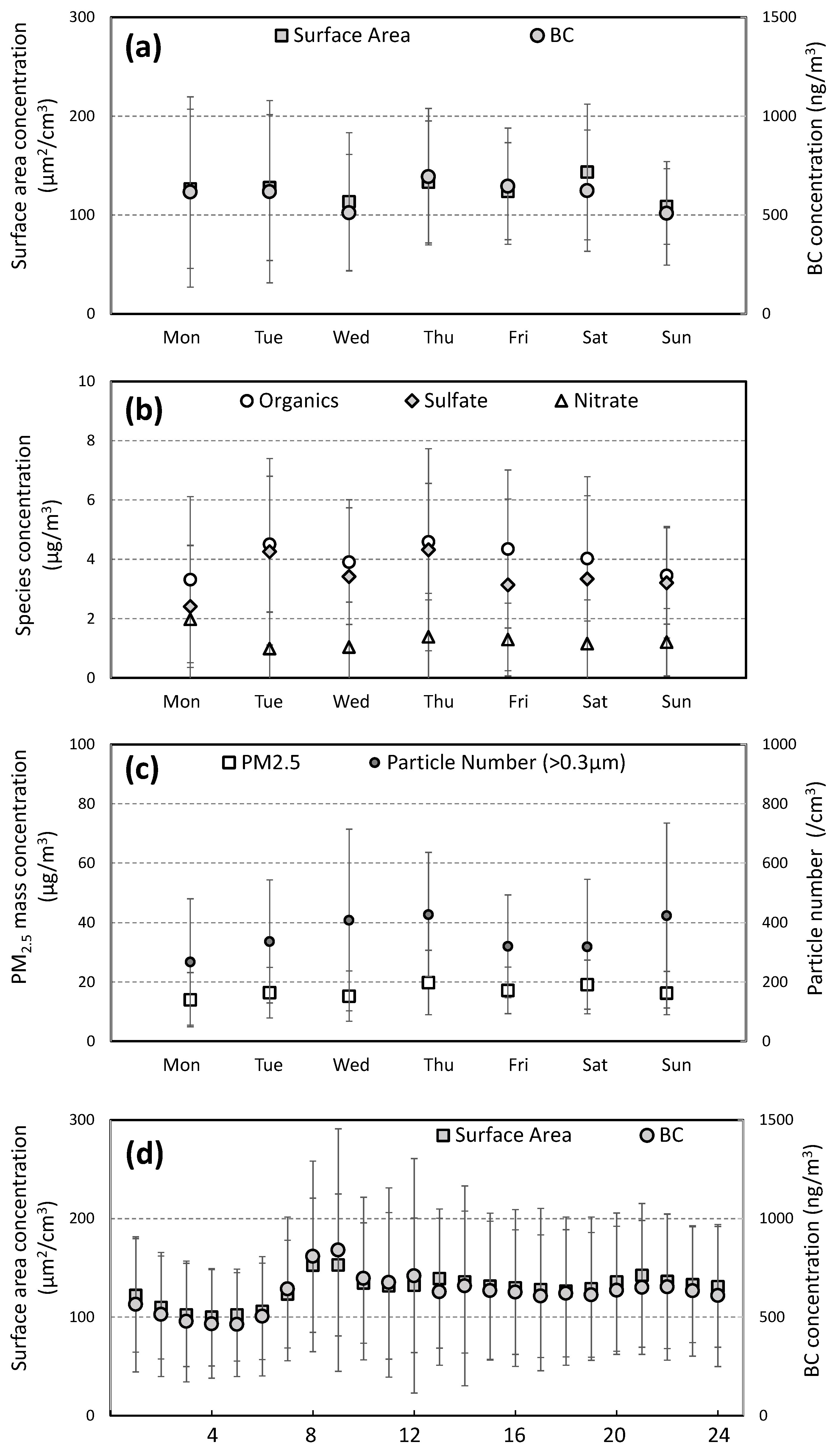
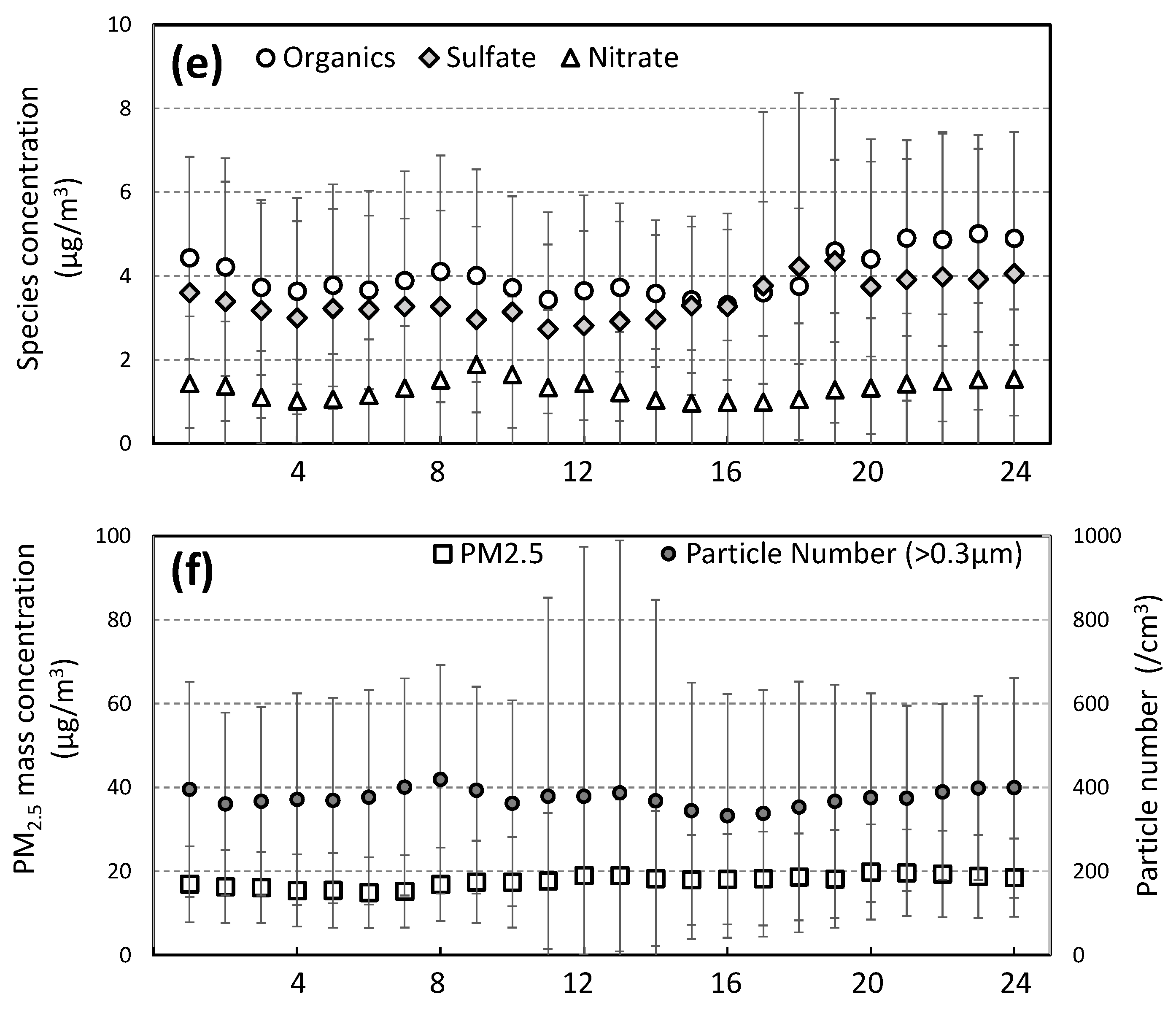
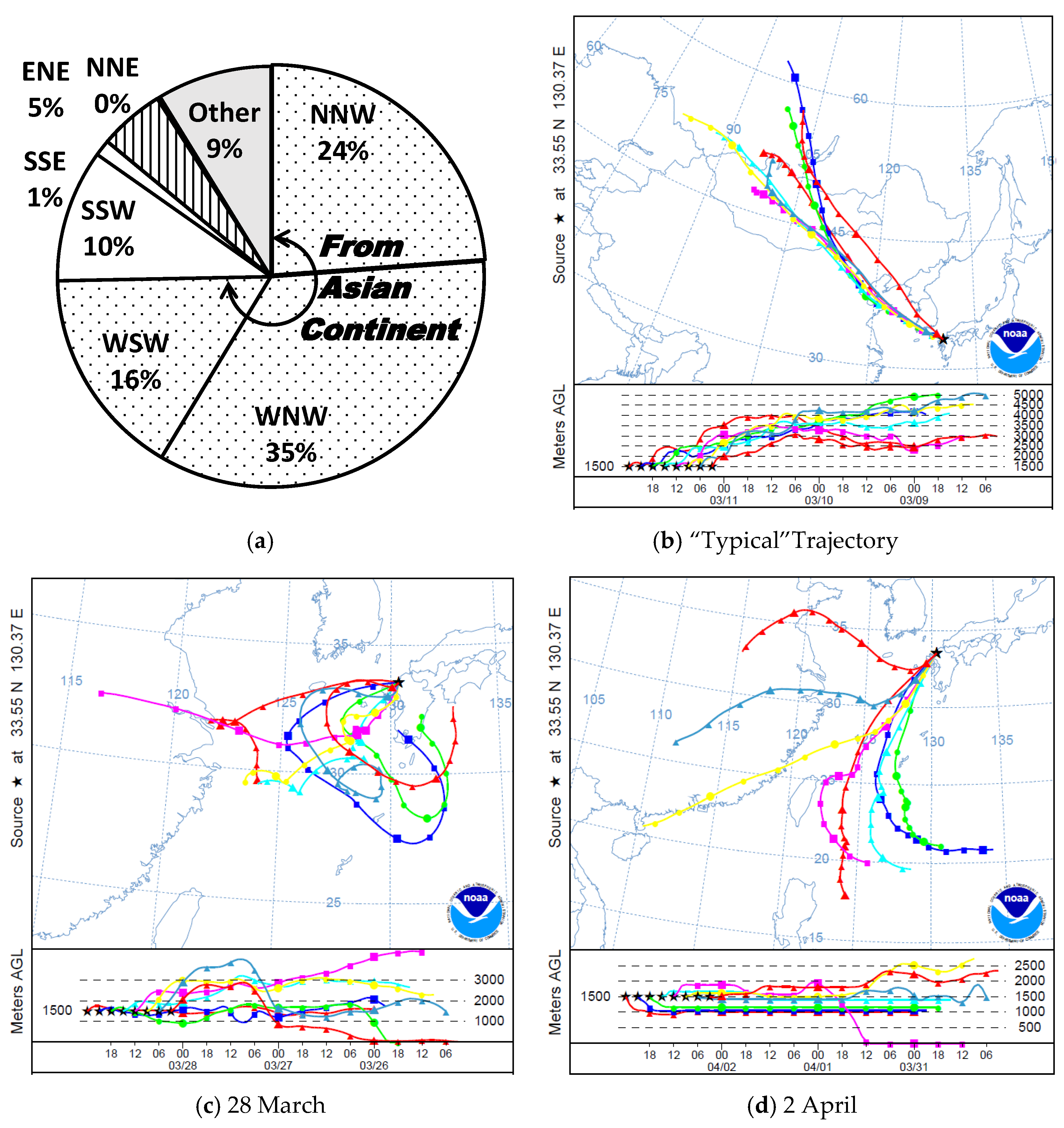


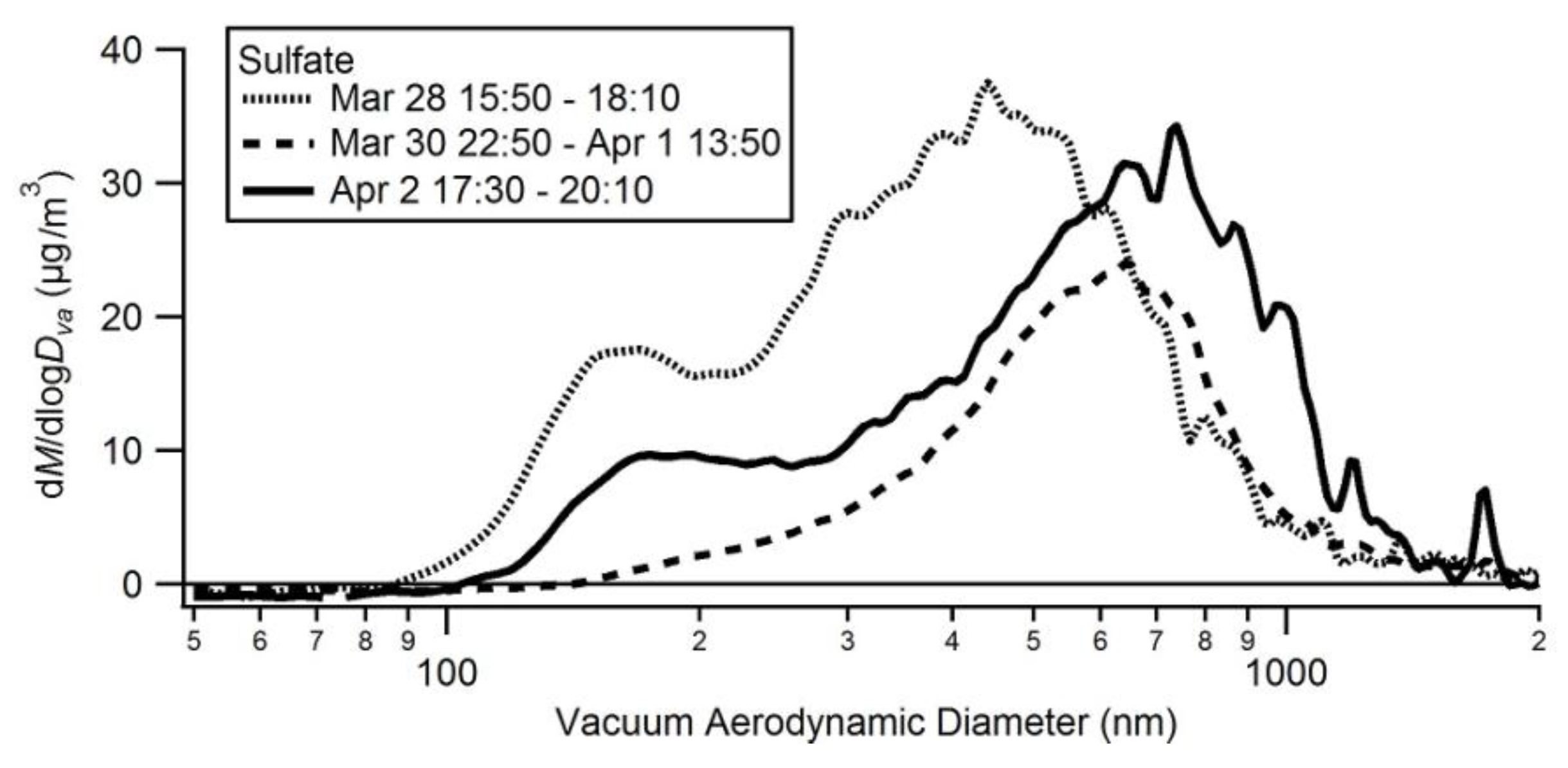
| Mean | SD | n | ||
|---|---|---|---|---|
| Surface Area | µm2/cm3 | 128 | 67 | 1035 |
| PM2.5 mass | µg/m3 | 17.6 | 11.4 | 1220 |
| BC | ng/m3 | 621 | 392 | 1150 |
| Organics | µg/m3 | 4.02 | 2.30 | 879 |
| NH4+ | µg/m3 | 1.52 | 0.97 | 879 |
| SO42− | µg/m3 | 3.43 | 2.85 | 879 |
| NO3− | µg/m3 | 1.30 | 1.60 | 879 |
| Cl− | µg/m3 | 0.12 | 0.11 | 879 |
| Particle Number (>0.3 μm) | #/cm3 | 375 | 318 | 919 |
| Surface Area | PM2.5 mass | BC | Organics | NH4+ | SO42− | NO3− | Cl− | Particle Number | |
|---|---|---|---|---|---|---|---|---|---|
| Surface Area | 1.00 | 0.57 | 0.74 | 0.67 | 0.57 | 0.41 | 0.46 | 0.22 | 0.43 |
| PM2.5 mass | - | 1.00 | 0.68 | 0.56 | 0.76 | 0.70 | 0.32 | 0.29 | 0.85 |
| BC | - | - | 1.00 | 0.63 | 0.52 | 0.32 | 0.48 | 0.31 | 0.64 |
| Organics | - | - | - | 1.00 | 0.52 | 0.35 | 0.49 | 0.40 | 0.42 |
| NH4+ | - | - | - | - | 1.00 | 0.85 | 0.55 | 0.51 | 0.76 |
| SO42− | - | - | - | - | - | 1.00 | 0.15 | 0.24 | 0.60 |
| NO3− | - | - | - | - | - | - | 1.00 | 0.61 | 0.47 |
| Cl− | - | - | - | - | - | - | - | 1.00 | 0.49 |
| Particle Number | - | - | - | - | - | - | - | - | 1.00 |
© 2016 by the authors; licensee MDPI, Basel, Switzerland. This article is an open access article distributed under the terms and conditions of the Creative Commons by Attribution (CC-BY) license (http://creativecommons.org/licenses/by/4.0/).
Share and Cite
Okuda, T.; Yamazaki, H.; Hatoya, K.; Kaneyasu, N.; Yoshino, A.; Takami, A.; Funato, K.; Inoue, K.; Nishita, C.; Hara, K.; et al. Factors Controlling the Variation of Aerosol Surface Area Concentrations Measured by a Diffusion Charger in Fukuoka, Japan. Atmosphere 2016, 7, 33. https://doi.org/10.3390/atmos7030033
Okuda T, Yamazaki H, Hatoya K, Kaneyasu N, Yoshino A, Takami A, Funato K, Inoue K, Nishita C, Hara K, et al. Factors Controlling the Variation of Aerosol Surface Area Concentrations Measured by a Diffusion Charger in Fukuoka, Japan. Atmosphere. 2016; 7(3):33. https://doi.org/10.3390/atmos7030033
Chicago/Turabian StyleOkuda, Tomoaki, Hana Yamazaki, Kazuki Hatoya, Naoki Kaneyasu, Ayako Yoshino, Akinori Takami, Koji Funato, Kozo Inoue, Chiharu Nishita, Keiichiro Hara, and et al. 2016. "Factors Controlling the Variation of Aerosol Surface Area Concentrations Measured by a Diffusion Charger in Fukuoka, Japan" Atmosphere 7, no. 3: 33. https://doi.org/10.3390/atmos7030033





